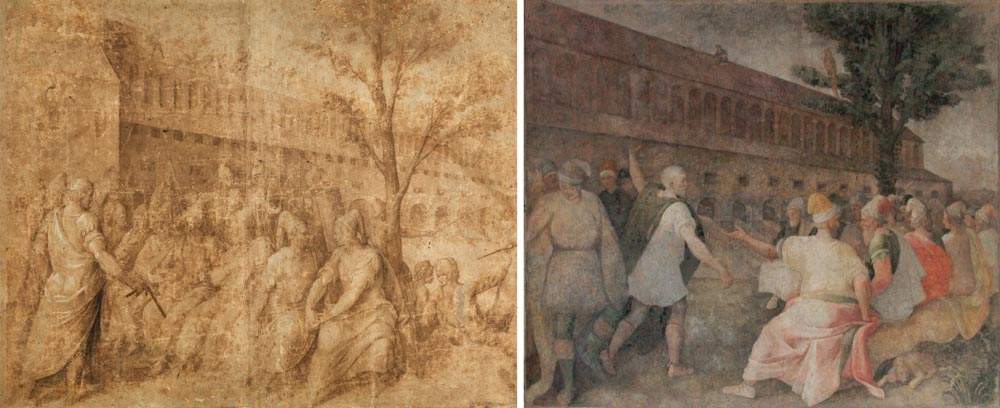New, important purchase for the Palazzo Ducale in Mantua: the museum in Piazza Sordello has in fact purchased, thanks to the support of Fondazione Comunità Mantovana, an important preparatory drawing by Lorenzo Costa the Younger (Mantua, 1537 - 1583) for one of the wall paintings in the Sala di Manto, specifically for the scene of the Construction of the Mill Bridge. Cost of the operation: 12,000 euros.
The work had been presented in an auction of the German house Hampel, which, moreover, had recognized neither author nor subject, as explained by the director of the Doge’s Palace, Stefano L’Occaso: “On June 29, 2023, the auction house Hampel in Munich put a drawing up for auction, without recognizing its nature. Presented as a work from the sphere of Primaticcio, interpreting the subject as Pythagoras and his school. Having identified it as a rare drawing by Lorenzo Costa, preparatory for the Sala di Manto and specifically for the scene of the ’Construction of the Bridge of Mills,’ I feared it might be lost in the rivulets of private collecting. If it didn’t, it is thanks to the Fondazione Comunità Mantovana, which I sincerely thank for its sensitivity and immediate response.”
The only other two known drawings for the same undertaking are preserved in the Gabinetto Disegni e Stampe at the Uffizi: like the drawing just purchased, they too are in a less than optimal state of preservation, but they are exceptional testimonies for Mantua. The Ducal Palace now harbors the desire to reunite the three drawings upon completion of the restoration of the Manto room that has just begun (currently the scene of the Construction of the Mill Bridge, facing the Santa Barbara corridor, is covered by scaffolding) and to be completed presumably in the fall of 2024.
“It is said that without roots the tree does not grow,” says the president of the Mantuan Community Foundation, Carlo Zanetti, “and so we were pleased and immediately ready to contribute to the recovery of such an important and significant document, as it was for the city the old Bridge of Mills, which still retains the prerogative of an important access route to the city, although it has lost the characteristic of a real economic hub, represented precisely by the mills. The synergy with Palazzo Ducale and its director Stefano L’Occaso was fundamental, and the way of collaboration with our Fondazione Comunità Mantovana proved to be immediately effective, benefiting the enrichment of the artistic and historical heritage of the city.”
The Sala di Manto is part of the immense halls that make up theAppartamento Grande of Castello, the highest expression of the monumentality of the Ducal Palace. The Appartamento Grande was anciently qualified as “royal,” according to a custom that dates back at least to the late 16th century; while work was still being done on its decorations, the king of France was in fact hosted there in 1574; in 1763, moreover, the emperor Charles VI was said to have slept in a room of this apartment. The largest room (312 square meters) is precisely the Sala di Manto, which acts as a hinge between the Castle, the Appartamento di Troia and the new rooms built in the 1770s for Duke Guglielmo Gonzaga. The large lower area of the walls is entirely covered with faux marble, on which there are various engravings and graffiti; above a stucco frame, in the upper band of the walls, are eight large scenes, dry-painted on the wall and now in a poor state of preservation. They must have been poorly legible even in the early 19th century, when a guide to the palace written by Antoldi judged the painted panels in the mirrors to be works by Andrea Mantegna depicting Stories of Aeneas. The misunderstanding determined the name “Aeneas’s” hall for the large room, and this name still recurs in the early 20th century, but later studies have assigned the room the name “Manto’s Hall,” after the protagonist of one of the stories painted in the mirrors of the upper order.
The current appearance of the Manto Hall is in any case due to the work conducted in the 1670s and begun under the prefecture of Giovan Battista Bertani, who died on April 2, 1576. However, the genesis of these rooms turns out to be rather complicated and their execution bumpy. By 1572 the massive coffered ceiling had been completed, by Venetian carvers, while the earliest news about the paintings dates from April 16, 1574, when the court of Mantua had made contact with a painter active in Venice, perhaps already Tintoretto, for the realization of eight canvases in the Manto room and four for the Capitani. No agreement was found, due to the artist’s exorbitant demands, and so Bertani, then prefect of the factories, had to be called upon to set up the paintings, envisaging an iconographic program that would trace “the medema Historia ch’is in that of the exhibition,” that is, in the gallery of the Exhibition in the Rustica, from the 1960s, but with “much fuller paintings, to be as large as they are, that such a painting will serà that there will come a hundred figures.” Bertani had to begin planning the paintings of the great hall, but death had to come in 1576 leaving the work unfinished. The continuation of the undertaking was entrusted to Lorenzo Costa il Giovane: an artist from Mantua, born in 1535, who after an initial local training had long worked in Rome with Federico Zuccari and Federico Barocci.
 |
| Mantua, Ducal Palace acquires rare preparatory drawing by Lorenzo Costa the Younger |
Warning: the translation into English of the original Italian article was created using automatic tools. We undertake to review all articles, but we do not guarantee the total absence of inaccuracies in the translation due to the program. You can find the original by clicking on the ITA button. If you find any mistake,please contact us.